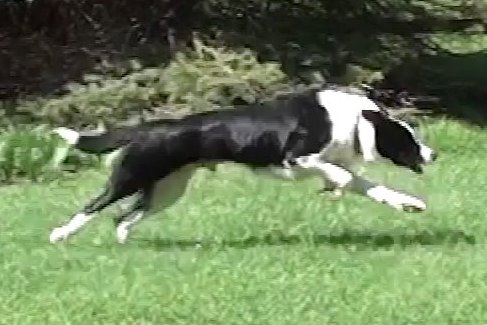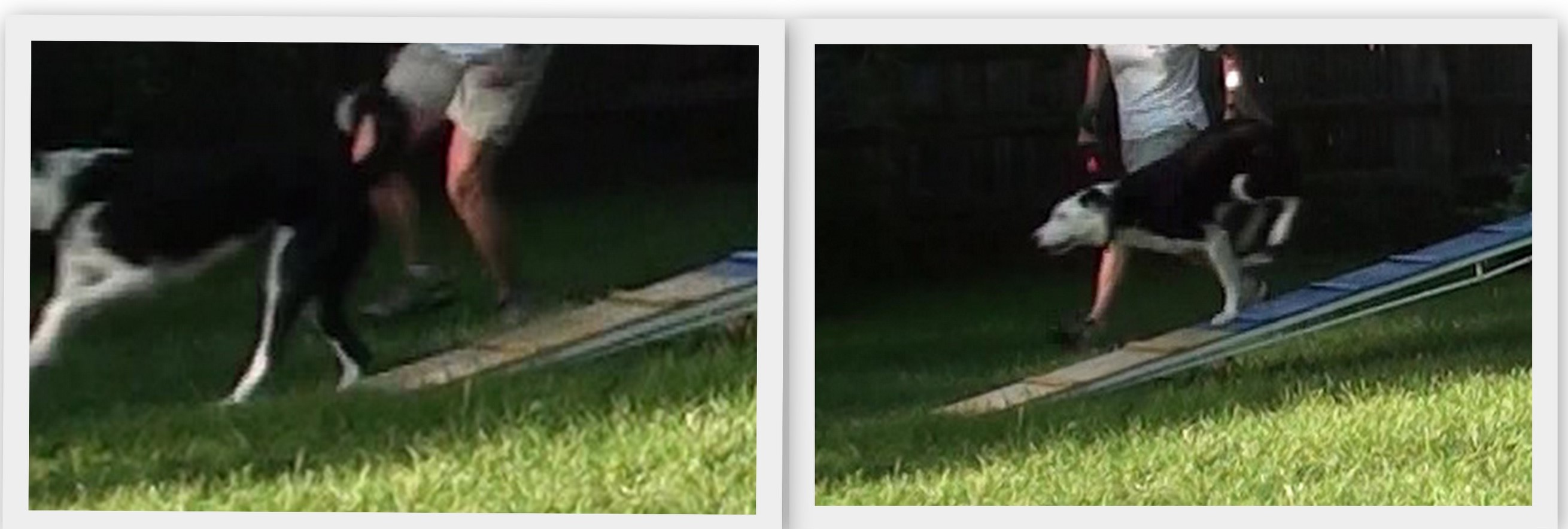Adventures in Running Contacts
Teaching Tai a running dog walk has been an adventure on many levels. It’s been fun, exhilarating, frustrating and challenging! I’m using Silvia Trkman’s method and fortunately have been able to participate in her on-line running contact classes. I entered into this project with the idea that – at the very least — all the plank work would lead to a solid foundation for the running A-frame and add speed to a stopped dog walk if I decided to go that way. But… that was before the addiction set in.
It has not been an easy journey for me or my long-legged boy. Well…I’ve largely been successful at keeping his frustration to a minimum. But he’s not the one who…after each 5-7 minute training session… often spends another 30 or more minutes analyzing the video, posting video, waiting for a response from Silvia, watching other videos, and thinking about how to proceed next. Hmmm… I did use the word “addiction”.
So, what is the behavior? It’s not just…get feet in the yellow. It’s finish your stride low on the board. If the dog understands this and is truly running – in double suspension gallop- even a long-strided dog like Tai will get 2 rear feet or 2 front feet or combination in the contact zone. Here are two pictures showing the compression and extension of a double stride gallop on the flat.
 So what have been our biggest challenges? 1. The biggest challenge of all is training the eye to see what is actually happening. To know what should be rewarded, jackpotted or not rewarded at all. It’s easy to see when the video is slowed down to 1/10th normal speed. Not at all easy to spot in the moment. I imagine it’s easier for some people than others. But spotting the correct behavior in the RDW was a real challenge for me – especially for a time when I had to discern the difference between front feet and rear feet hits. Yikes!
So what have been our biggest challenges? 1. The biggest challenge of all is training the eye to see what is actually happening. To know what should be rewarded, jackpotted or not rewarded at all. It’s easy to see when the video is slowed down to 1/10th normal speed. Not at all easy to spot in the moment. I imagine it’s easier for some people than others. But spotting the correct behavior in the RDW was a real challenge for me – especially for a time when I had to discern the difference between front feet and rear feet hits. Yikes!
2. Along the way, finding plank set-ups that would accommodate Tai’s stride length. Ultimately, going to a low full dogwalk was the answer.
3. The mechanics of throwing a toy reasonably far and true to path :-).
3.Solving the mystery of the “overreaching” problem we encountered once on the full and low dogwalk. The picture shows him working hard to land with rear feet on the ground, rather than on the board. A mystery solved, after much frustration on both our parts, by simply raising the height of the dog walk.
The picture shows him working hard to land with rear feet on the ground, rather than on the board. A mystery solved, after much frustration on both our parts, by simply raising the height of the dog walk.
4. Knowing what to do, when Tai wasn’t “getting it”. Being loose enough and strict enough in criteria.
5. Having faith 🙂
Ok…enough of words, you must be thinking…let’s see it! So, below is a short movie I put together to celebrate where we are in our journey. Still a work in progress – turns off the dogwalk, discriminations, new dogwalks and finishing the two on- two off behavior are ahead of us, but I’m feeling very confident that we’re definitely on track and will ultimately be successful. Yippee!
As one of my fellow on-line students wrote…”Running contact training is a great method for teaching the handler to deal with frustration ![]() but I will definitely be using this method with my next dog too because running contact heaven is worth spending some time in running contact hell
but I will definitely be using this method with my next dog too because running contact heaven is worth spending some time in running contact hell ![]() “. Amen.
“. Amen.